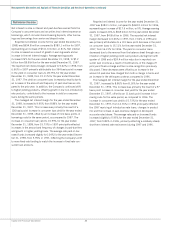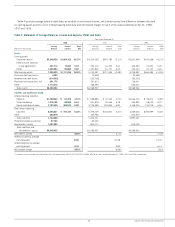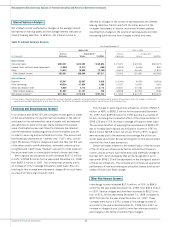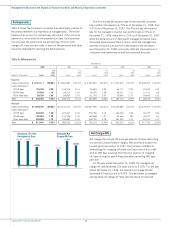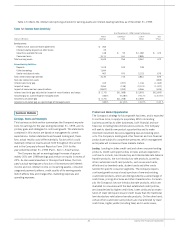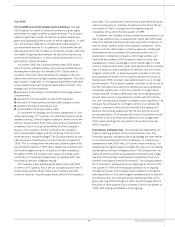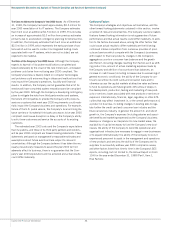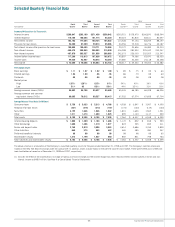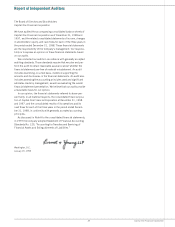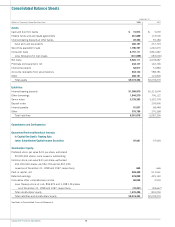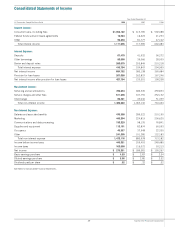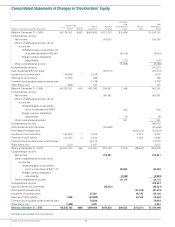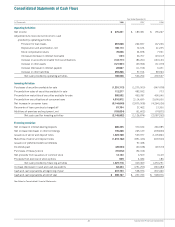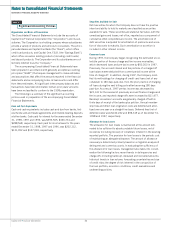Capital One 1998 Annual Report Download - page 34
Download and view the complete annual report
Please find page 34 of the 1998 Capital One annual report below. You can navigate through the pages in the report by either clicking on the pages listed below, or by using the keyword search tool below to find specific information within the annual report.
32Capital One Financial Corporation
Management’s Discussion and Analysis of Financial Condition and Results of Operations (continued)
increasing amounts of marketing. Intense competition in the credit
card market has resulted in a decrease in credit card response rates
and reduced productivity of marketing dollars invested in certain
lines of business. In addition, the cost to acquire new accounts
varies across product lines. With competition affecting the prof-
itability of existing introductory rate card products, the Company
has been allocating, and expects to continue to allocate, a greater
portion of its marketing expense to other customized credit card
products and other financial and non-financial products. Addition-
ally, the cost to acquire an America One wireless account includes
the cost of providing a free phone to the customer, and conse-
quently is substantially more than the cost to acquire a credit card
account. The Company intends to continue a flexible approach in
its allocation of marketing expenses. The actual amount of market-
ing investment is subject to a variety of external and internal fac-
tors, such as competition in the consumer credit industry, general
economic conditions affecting consumer credit performance,
the asset quality of the Company’s portfolio and the identification
of market opportunities across product lines that exceed the
Company’s targeted rates of return on investment.
The amount of marketing expense allocated to various product
segments will influence the characteristics of the Company’s portfo-
lio as the various product segments are characterized by different
account growth, loan growth and asset quality characteristics. The
Company currently expects continued strong account growth and
loan growth in 1999. Actual growth, however, may vary significantly
depending on the Company’s actual product mix and the level of
attrition on the Company’s managed portfolio, which is primarily
affected by competitive pressures.
Impact of Delinquencies, Charge-Offs and Attrition
The Company’s earnings are particularly sensitive to delinquencies
and charge-offs on the Company’s portfolio and on the level of attri-
tion due to competition in the credit card industry. As delinquency
levels fluctuate, the resulting amount of past-due and overlimit
fees, which are significant sources of revenue for the Company, will
also fluctuate. Further, the timing of revenues from increasing or
decreasing delinquencies precedes the related impact of higher or
lower charge-offs that ultimately result from varying levels of delin-
quencies. Delinquencies and net charge-offs are impacted by gen-
eral economic trends in consumer credit performance, including
bankruptcies, the continued seasoning of the Company’s portfolio
and the product mix.
The Company’s expectations for 1999 earnings are based on
management’s belief that consumer credit quality is stabilizing.
Management expects that during the first half of 1999 delinquen-
cies and charge-offs will remain stable. Management, however,
cautions that delinquency and charge-off levels are not always pre-
dictable and may vary from projections. In the case of an economic
downturn or recession, delinquencies and charge-offs are likely to
increase. In addition, competition in the credit card industry, as
measured by the volume of mail solicitations, remains very high.
Increased competition can affect the Company’s earnings by
increasing attrition of the Company’s outstanding loans (thereby
reducing interest and fee income) and by making it more difficult to
retain and attract more profitable customers.
higher delinquencies and credit losses than the Company’s tradi-
tional products. These products also involve higher operational
costs but exhibit better response rates, less adverse selection, less
attrition and a greater ability to reprice than the Company’s tradi-
tional introductory rate products. More importantly, as a whole, all
of these customized products continue to have less volatile returns
than the traditional products in recent market conditions.
On July 31, 1998, the Company completed the acquisition of
Summit Acceptance Corporation (“Summit”), a Texas corporation.
Summit is an indirect automobile finance lender located in Dallas,
Texas. Summit is the Company’s platform to test and apply its IBS
to the automobile loan market.
Telecommunications The Company expects to continue its efforts to
market telecommunications services through its subsidiary America
One Communications, Inc. (“America One”). America One’s initial
business, the reselling of wireless services through direct marketing
channels, has recently begun to experience growth in the number
of customers and accounts. As a result of the expenses necessary to
build the operations to support this new business and to acquire
new accounts, to date this business negatively impacts earnings.
International Expansion The Company has expanded its existing oper-
ations outside of the United States, with an initial focus on the
United Kingdom and Canada. The Company has experienced
growth in the number of accounts and loan balances in its interna-
tional business. To support the continued growth of its United King-
dom business and any future business in Europe, in July 1998, the
Company opened a new operations center in Nottingham, England.
The Company will continue to apply its IBS in an effort to bal-
ance the mix of credit card products with other financial and non-
financial products and services to optimize profitability within the
context of acceptable risk. The Company’s growth through expan-
sion and product diversification will be affected by the ability to
internally build or acquire the necessary operational and organiza-
tional infrastructure, recruit experienced personnel and fund these
new businesses. Although management believes it has the person-
nel, financial resources and business strategy necessary for contin-
ued success, there can be no assurance that the Company’s
historical financial performance will necessarily reflect its results of
operations and financial condition in the future.
Marketing Investment
The Company expects its 1999 marketing expenses to exceed
1998’s expense level, as the Company continues to invest in its
various credit card products and services, and other financial and
non-financial products and services. The Company cautions, how-
ever, that an increase in marketing expenses does not necessarily
equate to a comparable increase in outstanding balances or
accounts based on historical results. As the Company’s portfolio
continues to increase, additional growth to offset attrition requires


